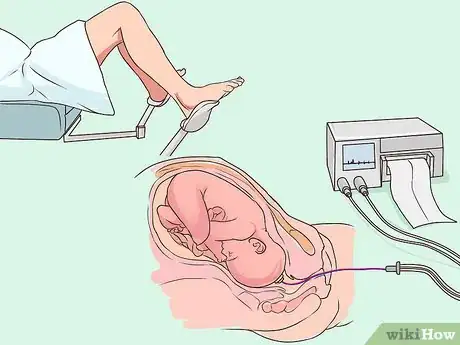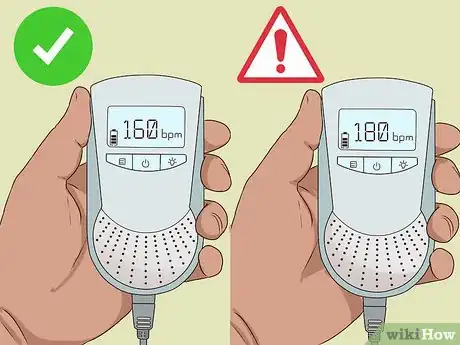This article was medically reviewed by Janice Litza, MD. Dr. Litza is a board certified Family Medicine Physician in Wisconsin. She is a practicing Physician and taught as a Clinical Professor for 13 years, after receiving her MD from the University of Wisconsin-Madison School of Medicine and Public Health in 1998.
There are 12 references cited in this article, which can be found at the bottom of the page.
This article has been viewed 18,063 times.
Tracking your baby's fetal heart rate during pregnancy can be an exciting way to follow their development. The best way to find the heart rate is to visit a doctor or ultrasound technician. They can check the heart rate using multiple techniques throughout pregnancy and during labor. You may even be able to hear the baby's heartbeat! While you can use a doppler device at home, keep in mind that these devices are not as reliable as professional medical equipment.
Steps
Undergoing an Examination during Pregnancy
-
1Visit a doctor or ultrasound technician. The best way to know the fetus’ heart rate is to have a medical professional perform an external examination. The doctor or technician will be able to locate the fetus using sophisticated equipment.[1]
- Your doctor may not be able to pick up on the fetal heart rate until between ten and fourteen weeks of development.
- Whoever performs the test will need to lift up your shirt or gown to reach your bare belly.[2]
-
2Stay still as the doctor listens to the uterus. The doctor may use a fetoscope, which is similar to a stethoscope. They will press one end of it to your stomach to listen for the fetus’ heartbeat. Wait patiently as they do this.[3]Advertisement
-
3Listen to your baby's heartbeat with a doppler device. A doppler device will let you hear the baby's heartbeat on an electronic monitor while measuring the heart rate. The technician will apply gel to your stomach before pressing a wand called a transducer to your skin.[4]
- Dopplers are typically used at the same time as ultrasounds. The baby's heart rate will be distinguishable because it will be much faster than your own.
- If your doctor or technician is unsure about which heart rate they are picking up, they will check your pulse and compare that to the rhythm of the fetus.
-
4Get treatment if there is a problem. Fetal heart rate alone cannot tell you if there is a problem or not. If the heart rate is abnormal, a doctor may do other tests to make sure that the fetus is in good health. Follow your doctor’s guidance and advice.[5]
- An abnormality isn't always a problem. Sometimes it can be as simple as the location of the placenta or your fetus being very active so you can hear movement but not a heart rate. Always check with your doctor, but don't panic before you speak with them.
Monitoring the Heartbeat during Labor
-
1Use intermittent monitoring if there are no complications. If your pregnancy is going relatively smoothly, you may only need intermittent monitoring during labor. This means that a nurse will check the heartbeat every fifteen to thirty minutes with a doppler device or fetoscope.[6]
- This is typically preferable because it lets you move around, walk, and change positions more organically during labor.
-
2Get continuous monitoring if there are complications. If the doctor suspects there is a problem, they may perform continuous monitoring. In this case, a doppler device will be attached to your stomach with a belt. This will monitor the baby’s heartbeat constantly throughout labor.[7]
- This method may be used if you have taken an epidural or oxytocin. It may also be used if there are complications with the pregnancy.
-
3Undergo internal monitoring if the heartbeat cannot be found. In some extreme cases, your doctor may need to insert a special wire into your cervix. This wire will attach to the fetus’ head. The doctor will get a more accurate measure of the baby’s heart rate.[8]
- Before this procedure, your doctor or nurse may do a vaginal exam first. They will then insert a catheter so that they can attach a wire to the baby. This can also help track the baby's movements.
- This is a more invasive procedure that can only be done after your water has broken. It is typically only done if the doctor cannot find the baby’s heart using an external monitor or if there are severe complications.
-
4Follow your doctor’s advice if there is a problem. If the doctor determines that there may be complications, follow their instructions. They may recommend further procedures to check on the health of the baby during labor.
Listening with a Doppler Device at Home
-
1Get a prescription. In the United States, you must have a prescription from a doctor to buy a doppler fetal heart monitor. Ask your doctor if this device is right for you. You may even ask them to demonstrate how to use it.[9]
- While there are no known problems with using doppler devices at home, it is best to have these tests done by a medical professional. Even with a device, you may not be able to recognize problems with the baby’s heartbeat without medical training.[10]
- While a doctor may be able to detect the heart rate as early as ten weeks, at-home doppler devices may not work until five months.[11]
-
2Apply gel to your belly. Lift up your shirt to reveal your bare belly. Squeeze ultrasound gel onto your stomach along your pubic bone or lower abdomen. Use the wand of the doppler device (called a transducer probe) to spread the gel over your skin.
- Ultrasound gel often comes with the device, although you may be able to purchase it separately.
-
3Press the transducer into the gel. You can guide the transducer probe around your pubic bone area. If you’re having difficulty finding the fetus, hold the wand at different angles. The fetus' heartbeat will sound like a strong, consistent pulse.
- Do not use the device for longer than ten minutes at a time. If you cannot find the heartbeat in that time, try again in a few days.
- It may be difficult to find the heartbeat using at-home devices. Visit a doctor for an external examination if you are concerned.
-
4Determine if the heart rate is normal. Once you locate the heartbeat, the heart rate will appear on the electronic monitor of the device. The baby’s heart rate should be between 110 and 160 beats per minute (bpm). The heart rate can vary between 5 and 25 beats from minute to minute.[12]
- If the fetus’ heart rate is between 160 and 180 bpm, they may have fetal tachycardia. Visit a doctor.[13]
- If the heart rate is between 60 and 100 bpm, you may have actually picked up on your own heart rate instead of the fetus’.[14]
- The fetal heart rate is not an accurate measure of health. Complications can still happen, even if the heartbeat is normal. Do not delay getting medical attention if you suspect something is wrong.[15]
-
5Visit the doctor if any abnormalities occur. If you are concerned that there is a problem, visit a doctor immediately. The doctor can perform more tests to determine if there is an issue.[16]
- If you have any abdominal pain, bleeding, dizziness, cramping, or discharge, see a doctor immediately, even if the fetus’ heart rate is normal.
- If you feel like your baby's activity has been reduced and it doesn't seem to respond to eating food or drinking water, you should check with your doctor.
- If you notice any change in the baby’s heart rate or if you notice an irregular pulse, call your doctor.
Warnings
- If you sense there is an issue with the baby, visit a doctor. Do not delay getting medical attention just because the fetus’ heart rate is normal.⧼thumbs_response⧽
- Only use ultrasound gel with the doppler device. Other gels can damage the machine.⧼thumbs_response⧽
References
- ↑ https://www.whattoexpect.com/pregnancy/ask-heidi/fetal-heart-monitors.aspx
- ↑ http://www.hopkinsmedicine.org/healthlibrary/test_procedures/gynecology/external_and_internal_heart_rate_monitoring_of_the_fetus_92,P07776/
- ↑ https://www.urmc.rochester.edu/encyclopedia/content.aspx?contenttypeid=92&contentid=P07776
- ↑ http://www.hopkinsmedicine.org/healthlibrary/test_procedures/gynecology/external_and_internal_heart_rate_monitoring_of_the_fetus_92,P07776/
- ↑ https://www.acog.org/Patients/FAQs/Fetal-Heart-Rate-Monitoring-During-Labor
- ↑ https://www.babycenter.com/0_fetal-monitoring_1451559.bc
- ↑ https://www.babycenter.com/0_fetal-monitoring_1451559.bc
- ↑ http://www.hopkinsmedicine.org/healthlibrary/test_procedures/gynecology/external_and_internal_heart_rate_monitoring_of_the_fetus_92,P07776/
- ↑ https://www.fda.gov/ForConsumers/ConsumerUpdates/ucm095508.htm
- ↑ https://www.fda.gov/ForConsumers/ConsumerUpdates/ucm095508.htm
- ↑ https://www.whattoexpect.com/pregnancy/ask-heidi/fetal-heart-monitors.aspx
- ↑ http://www.hopkinsmedicine.org/healthlibrary/test_procedures/gynecology/external_and_internal_heart_rate_monitoring_of_the_fetus_92,P07776/
- ↑ https://radiopaedia.org/articles/fetal-heart-rate
- ↑ http://www.merckmanuals.com/home/women-s-health-issues/normal-pregnancy/physical-changes-during-pregnancy
- ↑ https://www.bmj.com/bmj/section-pdf/186393?path=/bmj/339/7730/Feature.full.pdf
- ↑ https://www.womenshealth.gov/pregnancy/youre-pregnant-now-what/pregnancy-complications









































































Medical Disclaimer
The content of this article is not intended to be a substitute for professional medical advice, examination, diagnosis, or treatment. You should always contact your doctor or other qualified healthcare professional before starting, changing, or stopping any kind of health treatment.
Read More...